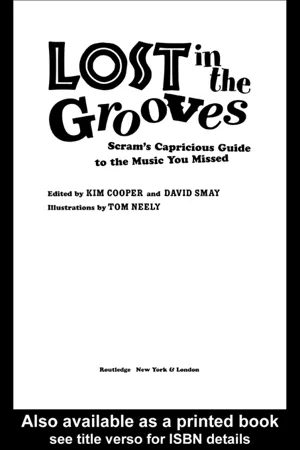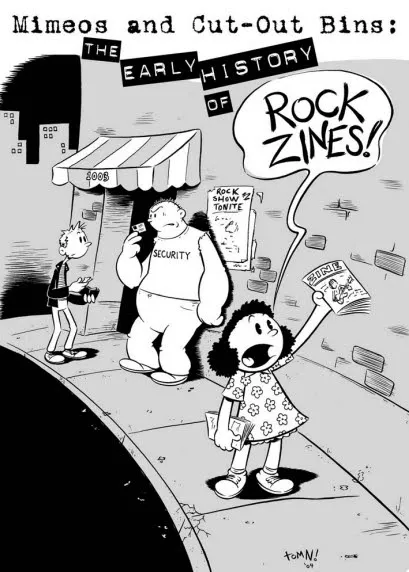![]()
![]()
Mimeos and Cut-Out Bins
Kim Cooper
The Early History of Rock Zines
Until the mid-sixties, press coverage of popular music was limited to the giddy burble of fan mags or the stolid cant of the trades. Rare exceptions—such as the progressive Jim Delehant-edited Hit Parader and Ralph Gleason’s criticism in the San Francisco Chronicle—were treasured by pop fans looking for more meat than Ringo’s ring size or Herman’s favorite cake. Then rock fanzines arrived on the scene, courtesy of science fiction freaks familiar with the genre’s self-publishing traditions. Zines contributed to an evolving critical language that would ultimately take two paths: into the gut or to the academy. The most compelling zines fused the two.
Starting in 1966, Paul Williams edited Crawdaddy, a somewhat hightoned and visually understated East Coast journal given to rhapsodizing over L.A.’s Love, Beach Boys and Doors. Budding critic Andy Shernoff found it “important but way too serious.” In the Haight, multicolored weekly Mojo-Navigator (co-edited by David Harris and seventeen-year-old Greg Shaw, of whom more later) offered a fan’s eye view of the San Francisco scene, with gossip, interviews and a critique of an antirock editorial in the underground Oracle.
Zines were widely traded, sold in hip shops, at gigs and on the street. Future Creem publisher Barry Kramer distributed titles through the Midwest. Greg Shaw and Chester Anderson launched the Underground Press Syndicate, a list of forty-plus mags that serviced each other with free copies.
Mojo-Navigator folded in late 1967, having overextended itself by switching from mimeograph to offset printing to meet national orders. In 1970, Shaw launched Who Put the Bomp (later just Bomp), which through the seventies would provide a home for rabid Merseybeat fandom, garage rock research and unabashed affection for then-unpopular artists like the Beach Boys. Bomp’s enthusiastic tone, combined with the cheapness of many of the out-of-print platters touted, made it appealing for readers to experiment with unknown acts.
Creem began as an underground tabloid covering the sociopolitical scene, but by 1971 found its voice as a snotty, often hilarious chronicler of rock and roll excess. Cover stories on popular acts frequently found the writer belittling them, while interior pages raved about more modest-selling staff favorites. Tuning into these discs made a reader feel part of the ultra-cool insider clique led by Lester Bangs. The reader might even get a letter printed in the magazine, with the editorial rimshot serving as proof of acceptance.
Boston’s Fusion packed windy gee-whiz cultural commentary and photo essays in the front of the book, but was an open door to freelance reviewers who section editor Gary Kenton allowed to freely pan big-label releases. Compelling longer features included Richard Meltzer’s affectionate ruminations on Johnny Mathis, and Mike Saunders ranking every recorded Zombies tune.
Around 1970, United Artists assigned publicist Greg Shaw to edit Phonograph Record Magazine, a house organ given away by radio stations and subject to minimal label oversight. PRM soon became paycheck and playground for a terrific crop of writers who could vote their conscience on discs new, notable, or noxious, while giving inches to pets like the Dolls, Todd Rundgren and the Move. Within a few years PRM would cut the corporate cord entirely, before ceasing publication in 1975.
And then there was Rolling Stone, which initially looked and functioned like an underground, but fast proved itself more concerned with maintaining a self-consciously hip tone than with passionately addressing the culture. Editors would routinely ask writers to change reviews if the thoughts expressed were critical of artists deemed above criticism. While many important pieces appeared in its pages, the organ inspired little affection, and some writers started their own zines in reaction against RS.
By the early seventies, rock critics formed networks of like-minded scribes who’d collide over junket appetizers or at the legendary 1973 Rock Writers Convention in Memphis, aka Day Zero for Big Star’s reputation. A critic-friendly band like the Raspberries would garner interchangeable reviews across the print spectrum (see Greg Shaw’s review of Fresh in this volume): a little moaning over such obvious derivative riffage, giving way to a shout of pure glee to have such perfect Beatlesque confections back on the airwaves again.
Leafing through a stack of vintage zines, well-known names are everywhere, from the mastheads to the letters columns. But look too for the ace craftsmen who wrote for love and never went pro, like Gene Sculatti’s faves Crescenzo Capece of Cretinous Contentions and “Hot” Scott Fischer, “a nutty St. Louis guy who, in ‘73 or so, dug only noise and space-rock.” Greg Shaw has warm memories of (girl group and exploitation mag scholar/future New York Rocker publisher) Alan Betrock’s exhaustively researched Jamz and Rock Marketplace. Before forming the Dictators, Andy Shernoff published Teenage Wasteland Gazette out of his folks’ house. TWG took delight in razzing foppish Jon Tiven, whose New Haven Rock Press featured columns by Nick Tosches and Richard Meltzer, and positive reviews of records ignored or maligned in Rolling Stone. Circa 1971–1972, Mark Shipper published two hilarious, ahead-of-their-time issues of Flash, dedicated to digging up great sounds in America’s bargain bins while attempting to restore the reputations of the DC5 and Paul Revere & the Raiders. The staff—including Saunders, Sculatti, Shaw, Ken Barnes, and Ed Ward—was solicited from a letter printed in Creem asking if anyone else was seeking out unknown cheapie discs. (You’ll find some of their favorites reprinted in this book.) In the mid-seventies, Back Door Man’s Don Waller and company covered the pre-punk, post-glitter L.A. scene with grit, style and just the right amount of arrogance.
A common scenario had zinesters realizing they could turn more people on, and even make a few bucks, by jettisoning print for vinyl. Miriam Linna teamed with Billy Miller and launched Kicks, which taught punks and wouldbe rockabillies about the deep back-story of hepness in America. They started releasing recordings under the Norton imprint and stopped zining. Bomp magazine folded as the label of the same name got busier with its Stooges and Stiv Bators releases. Slash had a few influential years of L.A. punk scene chronicling before issuing the debuts of X, the Germs and the Blasters. Meanwhile, V. Vale and Andrea Juno transformed their San Francisco punk zine Search & Destroy into the culturally influential RE/Search book series, offering ahead-of-the-zeitgeist titles on industrial culture, pranks, B-movies and zining itself.
In the eighties, zines became specialized: Ugly Things reported on lost sixties legends (and punk, as the contributors’ interests evolved), hardcore bible Maximum RocknRoll was the outlet for regional scene reports and insular Berkeley politics, while Forced Exposure celebrated the dark, noisy edges of the expanding alternative scene. By the early nineties, zines began their flirtation with the mainstream—review mags like Factsheet 5 conferred status on “Editor’s Choice” titles and listed hundreds of disparate publications in each issue, anthologies were published and some zinesters got book deals.
But the explosion of the zine scene coincided with the rise of the Internet, a medium that offered most of the pleasures of self-publishing without the pesky need to sell ads, negotiate distribution or pay the printer. Online, special interest list-servs and message boards allowed like-minded collectors to communicate, critics began keeping music-themed blogs and well-funded websites like allmusic.com became the URLs of record almost by default.
And yet, paper zines survive, many of them cleaving to the tradition of passionate advocacy that distinguished the Mojo-Navigator and its immediate descendants. This book’s contributors include the folks behind such worthy recent ventures as Cannot Become Obsolete, Caught in Flux, Cimmaron Weekend, Dagger, 8-Track Mind, Garage & Beat!, Roctober, and Worldly Remains, among others. If you dig their reviews, check out the contributors’ notes for ways to get their magazines.
A
The Action
Brain aka Rolled Gold | (Recorded 1967-68, released Parasol, 2002) |
Five young men from Kentish Town whose singles won repute at the height of Carnaby-era Britpop, the Action had daring, ability, imagination and no less a personage than George Martin as producer. They did tight, distinctively Anglo R&B rungs above other worthy background noise by the Birds or Downliners Sect. Reg King was one of the era’s great soul-crooners, classy as Pickett, expressive as Covay. Amazingly, the Action failed to chart in the cutthroat U.K. market and elsewhere drew no water at all. Their later bandwritten songs took a left-hand veer into brittle, understated psychedelia. Demos for the unreleased album reveal grainy textures, tough fragments of melody and a glass-skulled Panavision unity of mod perception so staggering one half-suspects that they were carelessly left behind by prankster kids from another dimension.
The Action swiped songcraft from Curtis Mayfield and Holland/ Dozier/Holland and assurance from entertaining fickle London mods, but sound here as if they’d been marinating in mescaline on the Strip. Since they only made double-A sides, there was no history of failure or limits. The opener is “Come Around,” a dry Movement anthem they dress up in G. Harrison motley to cut acid capers. Swooping harmonies and artful time changes prove they’ve got the whole 1967 clever-bastard thing wired. As the songs flash past, the critic hears innocent wonder, loneliness in the middle of a gigantic youth culture and the rolling clang of cash registers. London label execs heard no such thing, and the Action died in an attar sweeter than the Zombies.
Reg King checked out for a solo career. The addition of Ian Whiteman on keys eventually turned the Action into underrated acid-jazzbos Mighty Baby, whose 1969 self-titled debut stands with Atom Heart Mother and Mr. Fantasy. Five bonus tracks on the CD were the Action’s last demos, with “Only Dreaming” and “A Saying for Today” as lovely as anything from Brain. (Ron Garmon)
Adam and the Ants
| Kings of the Wild Frontier | (Epic, 1980) |
There’s a difference bet...


